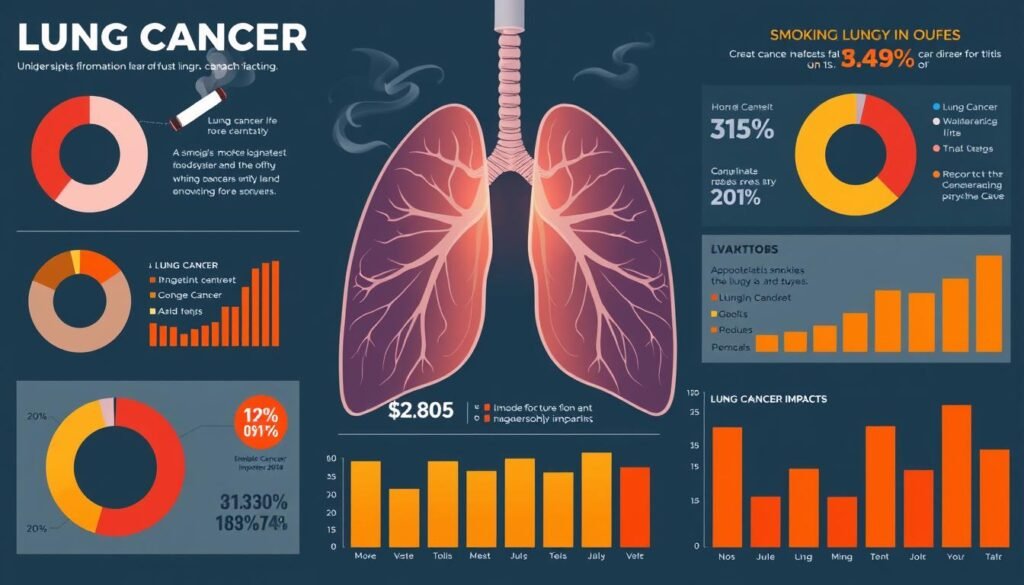Every year, 1 million people lose their lives to lung cancer around the world. This makes it the top cause of cancer deaths. Research shows a strong link between smoking and lung cancer. Nearly 90% of lung cancer risks in men, and 70-80% in women, are due to smoking. It’s crucial to grasp this connection as we fight this health crisis.
In the United States, lung cancer is expected to cause over 160,000 deaths every year. This highlights the need for education and prevention efforts. The rate of new lung cancer cases began to fall in 2006. Still, former smokers remain at high risk. The data and studies on smoking and lung cancer are key for public health plans. They also stress the need to teach people about lung cancer risks. For detailed data, check the global statistics on lung cancer.
Key Takeaways
- Lung cancer is the leading cause of cancer death globally, with over 1 million deaths each year.
- Smoking accounts for approximately 80% of lung cancer deaths.
- Smokers have a significantly increased risk of developing lung cancer compared to non-smokers.
- Screening for lung cancer can decrease mortality rates by up to 20% for high-risk individuals.
- Former smokers represent a growing proportion of lung cancer diagnoses.
- Public health strategies must prioritize awareness and prevention to combat lung cancer effectively.
The Link Between Smoking and Lung Cancer
About 80% of lung cancer deaths come from tobacco use. This fact points out how smoking is the top risk for lung cancer. It’s important to realize that this risk isn’t just from cigarettes. Cigars, pipes, and even menthol cigarettes are also dangerous.
Very few people who’ve never smoked get small cell lung cancer (SCLC). This shows how closely smoking and lung cancer are linked. Secondhand smoke is also a big problem. It’s the third leading cause of lung cancer in the U.S., proving that smoking affects more than just the smoker.
Smoking can change your genes and cause long-term inflammation. These changes make you more likely to get lung cancer. Being around radon, asbestos, and other workplace dangers plus smoking raises your risk even more. Smoking also doesn’t mix well with certain cancer treatments or supplements like beta-carotene.
We need to focus on smoking in our public health efforts. The risk of cancer isn’t just from smoking itself. It also comes from being around where cigarettes are used or made.
Understanding Lung Cancer Risks
Lung cancer is the third most common cancer in the nation. It follows breast and prostate cancer. About 235,000 new cases are diagnosed each year in the U.S. This shows how important it is to know the risks of lung cancer. Most cases are due to smoking, but not all. Factors like genetics and the environment also play a big role.
Things like radon gas and air pollution are big risks for lung cancer. Radon is a colorless, odorless gas that comes from the ground. It’s a major cause of lung cancer for people who don’t smoke. Also, living in places with lots of air pollution raises the risk. Knowing this helps us find ways to prevent lung cancer.
Researchers have learned a lot about genetics linked to lung cancer. They can now test for certain genetic markers. This testing helps doctors choose the best treatment for each person. Personalized treatment is key, especially because many cases are in people who have stopped smoking.
Lung cancer survival rates have gone up a lot in the last ten years. This is true especially when cancer is found early. Promoting early detection and screening is very important. Knowing all about the risks of lung cancer is essential for making good public health plans.
For more information on preventing and screening for lung cancer, readers can check out key findings in lung cancer research. This research talks about important topics and stresses the need for education and support. Through learning and action, we can help lower lung cancer rates and improve many lives.
Smoking and Its Carcinogenic Compounds
Cigarette smoke is full of harmful carcinogenic compounds. It has thousands of chemicals. Over 60 of them are known carcinogens. This includes things like polycyclic aromatic hydrocarbons and nitrosamines. These compounds play a big role in causing lung cancer and other types of cancer.
When people breathe in cigarette smoke, they harm their lungs. They expose lung tissues to these dangerous substances. This can cause irritation and inflammation that doesn’t go away. Over time, this may lead to cancer.
The dangerous parts of cigarette smoke have to be turned on by certain enzymes. Once activated, they can damage DNA, which is key to starting cancer. Smokers have more DNA damage in their lungs than non-smokers. This shows a clear link between smoking and a higher risk of lung cancer.
There are also tumor promoters in cigarette smoke. They make the main carcinogens even more dangerous. They increase the risk of getting lung cancer a lot. Every cigarette contains about 1.4 to 2.2 milligrams of these cancer-causing compounds. That’s a big risk with each smoking.
About 87% of lung cancer deaths come from smoking or secondhand smoke. Smokers are 25 times more likely to get lung cancer than non-smokers. The risks from smoking are huge, showing why it’s so important to stop smoking. For more information on the risks of cancer from smoking, check out this resource.
Squamous cell carcinoma is common in smokers. This makes finding and treating it early very important. Knowing about lung cancer can help doctors choose the right treatment. For details about squamous cell lung cancer, visit this link.
Smoking and Lung Cancer: Statistics and Research
The stats link smoking and lung cancer together. We’re looking at how smoking trends affect lung cancer rates. Some groups have higher rates because of their smoking habits.
Trends in Lung Cancer Incidence Among Smokers
Lung cancer is a big health issue, especially for smokers. About 75% of lung cancer deaths are because of smoking as of 2018. Even though fewer people are dying each year—2.7% less from 1991 to 2018—smoking still greatly increases lung cancer cases. In 2022, we saw over 2,480,675 new lung cancer cases.
The Demographic Divide in Lung Cancer Cases
Who gets lung cancer varies a lot by country and group. For instance, Turkey had the highest lung cancer rates in 2022 for both men (68.0 per 100,000) and women (66.3 per 100,000). The difference in lung cancer rates between smokers and non-smokers is striking. While smokers are at a higher risk, we can’t ignore lung cancer in people who never smoked. We need to focus on preventing and catching lung cancer early.

The Role of Secondhand Smoke Exposure
Secondhand smoke exposure is linked to serious health issues like lung cancer. Studies show significant risks for nonsmokers who breathe in tobacco smoke from others. This affects millions, causing respiratory problems and higher lung cancer risks.
Health Effects of Secondhand Smoke
Secondhand smoke has many bad health effects. It causes around 7,300 lung cancer deaths yearly in the U.S. among nonsmokers. Living with a smoker can increase your lung cancer risk by 20 to 30 percent.
Other health problems from passive smoking include:
- Increased heart disease risk, causing about 34,000 deaths a year.
- Higher stroke risk by 20 to 30 percent.
- Bad effects on pregnancy, like low birth weight and poor lung development in babies.
Statistics on Secondhand Smoke and Lung Cancer Risk
Many studies show a clear link between secondhand smoke and lung cancer risk. Over 50 studies found that exposure increases the risk for nonsmokers. Key findings include:
| Type of Lung Cancer | Odds Ratio (OR) |
|---|---|
| All Histological Types Combined | 1.31 |
| Adenocarcinoma | 1.26 |
| Squamous Cell Carcinoma | 1.41 |
| Large Cell Lung Cancer | 1.48 |
| Small Cell Lung Cancer | 3.09 |
The data clearly shows a higher lung cancer risk from secondhand smoke. This highlights the need for strategies to reduce exposure.
Insights from Recent Lung Cancer Research
Recent lung cancer studies have uncovered major advances. These advances help us better understand the disease. Thanks to immunotherapy and targeted therapies, we see improvements in how patients fare.
The research looked at over 129,000 lung cancer cases across the U.S. It linked genetic factors to how well treatments work. This is a big step forward in fighting lung cancer.
One key area of research is finding new biomarkers. These biomarkers can tell us how lung cancer will progress. They also show how well treatments might work. There’s a push to study people who have never smoked. About 12% of lung cancer patients never used cigarettes. Women make up 16% of these non-smoking patients.
The link between smoking and lung cancer is still vital. Smoking even one more cigarette per day can lead to more lung cancer cases. This increase happens 20-30 years after smoking rates go up. The data underlines how past smoking habits affect lung cancer today.
- About 80% of lung cancer deaths are linked to smoking.
- Adenocarcinoma is the most common lung cancer among non-smokers.
- 90% of diagnosed smokers are men, while 84% are women.
Lung cancer research is taking a broad approach. It looks at how smoking affects the disease. But it also explores treatments and genetics for all types of lung cancer. This work is crucial. It’s about finding ways to fight lung cancer from every angle.

| Country | Adult Daily Tobacco Smokers (%) | Age-Standardized Lung Cancer Incidence Rate (per 100,000) for Women |
|---|---|---|
| Canada | 8.6 | 31.6 |
| Norway | 9.0 | 26.7 |
| Sweden | 10.2 | 18.3 |
Smoking Cessation Programs and Their Effectiveness
Smoking cessation programs are key to lowering lung cancer risks. They use methods like counseling, nicotine replacements, and medicines. Making more people aware of how well these programs work can help more smokers quit.
Statistics on Smoking Cessation Success Rates
There’s good news in the numbers for quitting smoking, especially when talking about lung cancer. Quitting smoking before getting screened can hugely lower death rates. An Italian study from the MILD trial found that people who had quit smoking had a 39% reduction in overall mortality compared to those still smoking. Plus, people who stopped smoking while being studied had a hazard ratio of 0.65. This shows quitting is effective.
About 40% of smokers stop within two years after finding out they have lung cancer. This proves continuous support is crucial. A study showed that lung cancer screening plus one stop-smoking help could reduce deaths more than just screening by itself.
Even though it’s hard and more than half of smokers with lung cancer keep smoking, quitting smoking is very impactful. The benefits start quickly, with better oxygen levels and lower blood pressure. We need to spread the word about these programs. Through strong support and health efforts, we can get more people to quit smoking. This will lead to better health for those facing lung cancer.
Tobacco Industry Regulations and Public Health Initiatives
Tobacco rules are key in fighting smoking and its bad effects. Strategies like ad limits and warning labels on products are crucial. They make people aware of tobacco dangers and keep the youth from starting.
Higher taxes on tobacco help deter people from smoking. For instance, raising prices by 10% cuts down smoking by 3%-4%. This effect is strongest among people with less money. In New York, a huge cigarette tax of $5.35 per pack significantly lowered smoking rates.
Community efforts are also important in public health. They teach about the risks of smoking and help people stop. Given that one out of three cancers come from tobacco, fighting tobacco is vital. Doing so could stop 1.65 million lung cancer cases in Europe over twenty years.
Banning smoking in public places helps prevent cancer. It stops people from starting to smoke and helps smokers quit. Since 80%-90% of lung cancers come from tobacco, strong rules and health actions are essential.

Anti-Smoking Campaigns: A Look at Their Impact
Anti-smoking campaigns are key in raising awareness about the dangers of using tobacco. They help lower smoking rates among different groups. The “Tips From Former Smokers™” campaign is a great example. It encouraged about 1.64 million Americans to try quitting smoking. Thanks to this effort, nearly 100,000 people might stop smoking for good.
Smoking kills more than 480,000 people every year in the U.S. Moreover, secondhand smoke takes around 41,000 lives. These numbers highlight why strong anti-smoking efforts are needed. In 50 years, adult smoking rates have fallen from 43% to 18%. This decrease is thanks to public health campaigns.
Anti-tobacco ads show the real dangers of smoking. However, some critics believe these ads can make people feel bad and stigmatize lung cancer patients. This stigma can worsen their healthcare experiences, leading to late diagnoses and poor quality of life.
Despite these hurdles, it’s vital to keep pushing anti-smoking campaigns. They raise awareness and aim to lower smoking rates even more. Using media and community projects is key to their success. By busting myths and educating people, these efforts support healthier living and lessen tobacco use nationwide.
Lung Cancer Screening and Early Detection Methods
Lung cancer screening is key to catching it early, which boosts survival chances. Low-dose computed tomography (LDCT) is now the top choice for spotting lung cancer early. This allows for starting treatment sooner. The American Cancer Society suggests those 50 to 80 years old, especially heavy smokers, get screened regularly. They recommend yearly LDCT scans for those who’ve smoked heavily for 20 years.
LDCT has proven better than the usual chest x-rays. Traditional x-rays don’t help people live longer in lung cancer cases. But, LDCT can find lung cancer sooner and has been shown to lower death rates by 20% in those at high risk.
Screening isn’t right for everyone. LDCT scans do expose you to some radiation. It’s more than a chest x-ray but less than a regular CT scan. Health pros weigh many factors to decide if screening is good for you, like your health and treatment choices.
Effective screening needs skilled facilities and teams. This ensures proper care after the scan. Luckily, Medicare and many insurances cover lung cancer screening. This helps many people get screened.
Talking to your doctor before screening is crucial. It helps you understand the why, the benefits, and the risks. Remember, screening can’t take the place of quitting smoking. Stopping smoking greatly reduces your lung cancer risk.
| Screening Method | Pros | Cons |
|---|---|---|
| Low-Dose CT (LDCT) | Improves early detection, reduces lung cancer mortality by 20%, non-invasive | Exposes to small radiation, may lead to further tests, not all cancers detected |
| Chest X-ray | Widely available, less radiation | No proven survival benefit, less effective in early detection |
Lung cancer is the top cancer killer in the U.S. By focusing on early detection through screening, we can improve public health. Catching it early is essential to beat this deadly disease.
Conclusion
The link between smoking and lung cancer is strong and worrisome. Smoking’s rise in the last century is linked to more lung cancer, especially in American men by the 1950s. A study by the American Cancer Society shows quitting smoking is key to prevent lung cancer.
Public health work has cut lung cancer death rates by 34% in men since 1990. Women’s rates have been dropping since 2002. These changes show how effective quitting smoking can be. Yet, we must keep educating people to lower lung cancer rates further.
To beat lung cancer, we need ongoing research and better health policies. We must also push for quitting smoking. By understanding smoking risks and choosing healthier lives, we can all help lower lung cancer rates together.